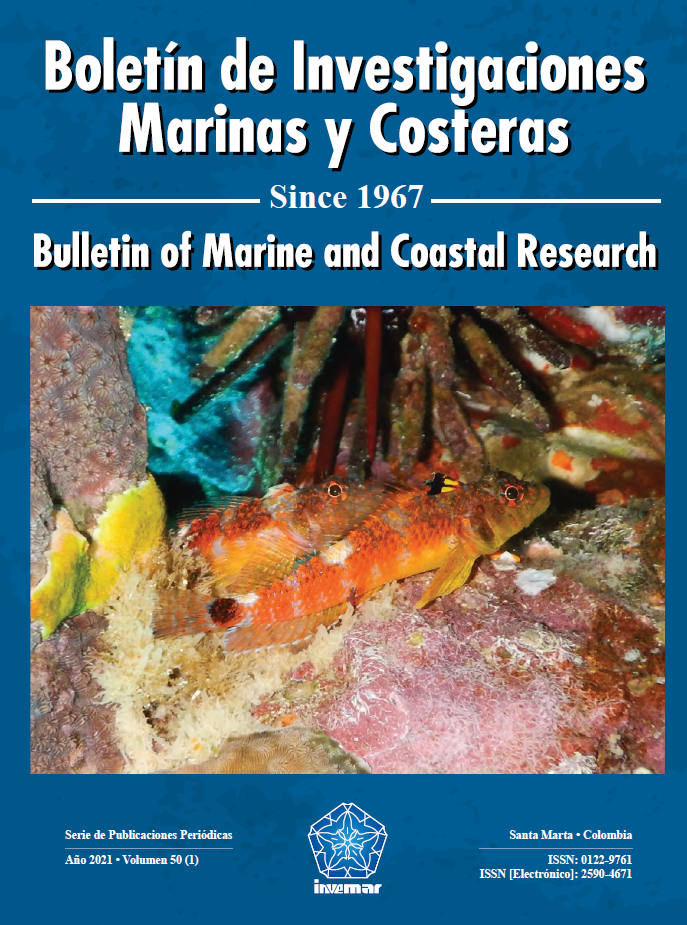Quantitative and qualitative analysis of contaminating hydrocarbons in the Gulf of Santiago de Cuba by gas chromatography
Published 2021-06-30
Keywords
- Pollution,,
- Hydrocarbons,,
- Bay,,
- Gas chromatography
How to Cite
Copyright (c) 2021 Bulletin of Marine and Coastal Research

This work is licensed under a Creative Commons Attribution-NonCommercial-ShareAlike 4.0 International License.
Abstract
The coasts of Cuba are exposed to damage caused by the contamination by petroleum hydrocarbons. The coastal strip of the Gulf of Santiago de Cuba is an example of natural resources deterioration due to this contamination, which appears as one of its main
environmental problems. In the present work, using gas chromatography, quantitative and qualitative analysis were performed based on the retention time values and the area under the chromatogram curve, which allowed characterizing the degree of contamination at four points of the bay of Santiago de Cuba: playa La Estrella (P1), “Guillermón Moncada” Port (P2) “Hermanos Díaz” Oil Refinery (P3), “Antonio Maceo” Thermoelectric Power Plant RENTE (P4). Retention times of individual peaks in chromatograms of individual samples with several standards, thus obtaining the types of hydrocarbons present at each point, with points P2 and P3 being the ones with the highest pollutant and the highest concentration by peak height. Fuel oil turned out to be the most polluting agent present in the bay.
Downloads
References
- EPA Method, 4. (2010). Total petroleum hydrocarbons (TPH).
- NC ISO, 5.-3. (1994). Oficina Nacional de Normalización, Calidad del agua muestreo, Guía para la preservación y manipulación de muestras, parte 3.
- Alzaga, R., Montuori, P., Ortiz, L., & Bayona, J. M. (2004). Fast solid-phase extraction-gas chromatography-mass spectrometry procedure for oil fingerprinting. Aplication to the Prestige oil spill. Journall of Chromatography A, 1025, 133-138.
- Castillo B., M. E., Herrera F., J. G., Acevedo B., R. L., & Severiche S., C. A. (2013). Evaluación analítica para la determinación de hidrocarburos totales en aguas por espectroscopia infrarroja. Bolivian Journal of Chemistry. Vol. 30, No.2, 146-152.
- Etxebarria, N., Zuloaga, O., Olivares, M., Bartolomé, L. J., & Navarro, P. (2009). Retention-time locked methods in gas chromatography. Journal of Chromatography A, 1624–1629.
- Falcón N, C. (2007). Análisis del sistema de transporte en la interfase Ciudad - Bahía de Santiago de Cuba con criterio de MIZC. . Santiago de Cuba, Cuba: Tesis presentada en opción al título académico de Máster en Manejo Integrado de Zonas Costeras. .
- Fernández L., M. A., Rodríguez H., D., García U., I., Santana G., M. A., & Córdova R., V. (2015). Comportamiento de la contaminación orgánica de la Bahía de Santiado de Cuba. Ciencia en su PC(1).
- Gallota, F. D., & Chistensen, J. H. (2012). Source identification of petroleum hydrocarbons in soil and sediments from. Journal of Chromatography A, 149–158.
- Jaramillo, R., & Dorman, F. L. (2019). Retention Time Prediction of Hydrocarbons in Cryogenically Modulated Comprehensive Two- Dimensional Gas Chromatography: A Method Development and Translation Application. Journal of Chromatography A, https://doi.org/10.1016/j.chroma.2019.460696.
- Morrison, A. E., Dhoonmoon, C., & White, H. K. (2018). Chemical characterization of natural and anthropogenic-derived oil residues. Marine Pollution Bulletin, 501-508.
- Novelli, G., Guigand , C. M., Boufadel, M. C., & Ozgokmen, T. M. (2020). On the transport and landfall of marine oil spills, laboratory and field observations. Marine Pollution Bulletin, 1-13.
- Prebihalo, S., Brockman, A., Cochran, J., & Dorman, F. L. (2015). Determination of emerging contaminants in wastewater utilizing comprehensive two-dimensional gas-chromatography coupled with time-of-flight mass spectrometry. Journal of Chromatography A, 1-7.
- Wang, S., Guo, G., Yan, Z., Lu, G., Wang, Q., & Li, F. (2010). The development of a method for the qualitative and quantitative determination of petroleum hydrocarbon components using thin-layer chromatography with flame ionization detection. Journal of Chromatography A, 1217, 368–374.
